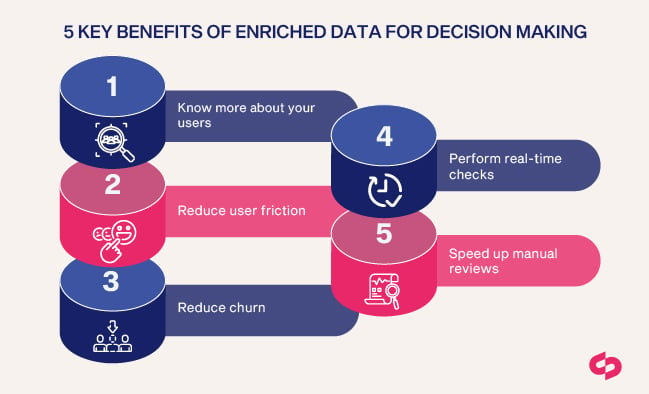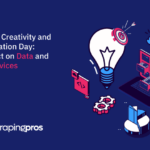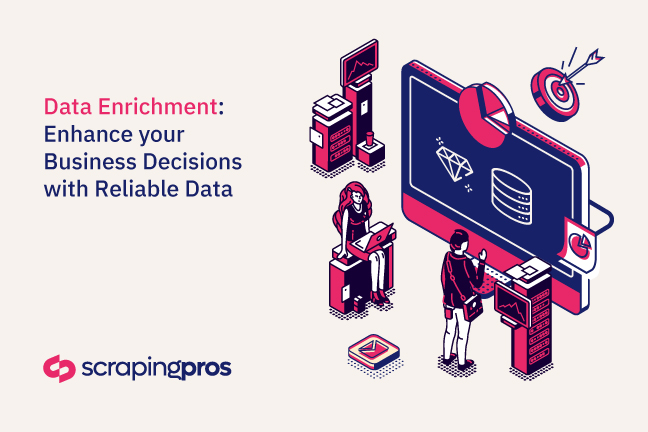Data enrichment is the key to improving your business decisions and increasing the profitability of your company. With this technical process, you can learn more about your customers without asking them for additional information and you can significantly improve the customer experience.
Data enrichment is the process of adding additional information to existing data to make it more useful and valuable. This information can be extracted from various sources; either through external databases, internal company data, web scraping techniques, data mining, use of third-party APIs, or entered manually.
The data enrichment process can be implemented in various ways. On the one hand, it can be done manually, involving the task of individually adding data to an existing set. This methodology can be laborious, but it allows granular control of the information that is added. In another sense, enrichment can also come from external sources. This means that data is added from other databases or spreadsheets, expanding the volume of information from previously existing resources.
On the other hand, an indirect but equally valid way to enrich data is through data cleaning. If there is no valuable information to add, improving the quality of the existing data set may involve removing inconsistencies and errors present in the data. Finally, integration refers to the combination of data from various sources into a single data set. This approach often involves extraction, transformation, and loading processes, which seek to unify and enrich data from different sources. Each of these strategies has as its ultimate goal of increasing the utility and value of existing data sets.
Why your business needs data enrichment
Data enrichment can significantly improve the customer experience. Some industry research shows the importance of personalized customer experiences:
- 66% of customers want brands to understand their unique needs and expectations.
- 52% want all the offers that come from a brand to be personalized.
- 54% of customers say they are likely to look at items in-store and buy online (or vice versa), and 53% of brands are investing in omnichannel strategies to match.
Accurate and rich data is the key to creating targeted and personalized customer experiences, and a lack of it can drive customers away. Data enrichment can also help lower your overall costs: With a strong data enrichment strategy, your focus is on preserving data that is important to your business, such as customer contact information or transaction histories. Other less relevant data may then be deleted or moved to lower-cost long-term storage sites. In addition, enrichment makes it possible to detect and remove redundant data to reduce overhead.
Importance of data quality for compliance and managerial decision-making
Quality data enables better decision-making, better customer experiences, and compliance with laws and regulations. It enables top management and other stakeholders to make informed decisions.
There is a direct cross between the quality of the data and compliance with it. For example, data protection laws, such as the General Data Protection Regulation (GDPR), require companies to correct inaccurate or incomplete personal information. To maintain high standards of data quality, companies must ensure the accuracy of their information. Data inaccuracies are often the main cause of data breaches (accounting for 88% of UK data breaches for example) which is one of the reasons these laws exist.
The main benefits of data enrichment
When it comes to businesses, the more data you have, the smarter your business decisions can be. This is especially true for companies that lack critical data, for example When: Entering a new market, looking to keep up with the latest trends, or starting a new business (such as moving from a physical store to an online), they try to reduce customer friction by collecting only essential information, they seek to improve segmentation and reduce fraud rates.
The main benefits of implementing data enrichment in your business are:

- Know more about your users: This is important to reduce risk and fraud
- Reduce user friction: No need to ask them to fill out dozens of fields. You can run checks in the background without interrupting the user journey.
- Reduce churn: Putting obstacles in the user journey tends to generate churn, for example in the form of cart abandonment.
- Perform real-time checks: A good data enrichment tool should deliver real-time results.
- Speed up manual reviews: Not sure about a medium-risk transaction? Run the data through a data enrichment module to make a better-informed decision.
Types of data enrichment
We highlight 5 types of data enrichment, each with its own purpose and specific applications:
- Demographic enrichment: Information such as age, income, gender, and geographic location is added to the data set. This type of enrichment is particularly useful in market segmentation, allowing companies to tailor their marketing strategies to specific demographic groups.
- Firmographic enrichment: Adds information such as a company’s industry, billing, and number of employees. This is vital for B2B lead generation, allowing companies to identify prospects with specific characteristics.
- Technological enrichment: Information about the company’s technological stack is added, including the software and hardware used. This type of data enrichment can help technology companies better understand the needs and limitations of their customers.
- Contextual enrichment: The context where an activity or event occurred related to the existing dataset is added. Of great value in industries where context can influence the interpretation of data, such as in social network analysis or consumer behavior studies.
- Preferential enrichment: Data related to the user’s online behavior, such as websites visited or survey results, is added. Which can improve the personalization and effectiveness of digital marketing strategies.
In which industries can data enrichment be used?
Data enrichment can be used in different industries, such as:
- Advertising: By enriching customer data with information about their behavior and preferences, companies can create optimized marketing campaigns for a specific target.
- Health: By adding -and maintaining rigorous- information about the patient such as preferences, allergies, and income history; medical personnel can provide closer and more effective care.
- Retail: Retailers can use data enrichment to better understand their customer’s buying preferences and adjust their inventory and marketing strategies accordingly.
- Finance, Banking, and Fintech: Financial analysts can make more sensible decisions thanks to having additional information about the performance of the company and industry trends.
- E-Commerce: Online stores can enrich their data with demographic and preference information to personalize user experiences, improve product recommendations, and optimize their digital marketing campaigns.
Best Practices
While every company’s enrichment process will be different depending on the type of data they collect and their strategic business goals, there are common best practices that can benefit brands no matter their approach.
- Create clear criteria: The first thing is to create clear criteria. This means considering the goal of your data enrichment efforts and then defining criteria that help you measure this goal. For example, if you are looking to improve the completeness and accuracy of customer data, you might set a goal of having 90% or better data accuracy in customer profiles when compared to a third-party verification source. If the goals are not met, you know more work is needed.
- Make processes repeatable: The next thing is to develop repeatable processes. Designing and implementing new processes over and over again is a waste of time and money. By creating frameworks for data analysis that are consistent and reliable, you can apply them to more than one enrichment effort. Consider the process of verifying customer profile data using a set of standard third-party sources. By creating a process that automatically checks these sites for specific types of data, you can simply reapply the feature as needed.
- Make sure efforts can scale: As your data volumes grow, you want enrichment efforts that can scale together. In practice, this means implementing automation wherever possible to eliminate manual touchpoints that could introduce additional complexity or unexpected errors.
- Prioritize general applications: Finally, it is worth thinking about how the processes will be generalized to other data sets. For example, if you create a process to verify customer data submitted through desktop website forms, it’s a good idea to leverage partners or services that can ensure that this process also applies to mobile users.
- Data enrichment is an ongoing process: Data enrichment is not a one-time process. Instead, effective enrichment requires ongoing effort to ensure that the data collected is relevant, accurate, and timely. Data never stops flowing to or from your organization, and your data environment is constantly changing. To ensure you get the most value from your data sources, continuous enrichment is critical.
Challenges and Future Considerations
There are several aspects to take into account when putting data enrichment into practice:
- Quality: The data being added must be accurate and up-to-date, this can be achieved by using trusted sources and regular data cleaning.
- Privacy: Data protection laws must be taken into account when carrying out the data enrichment process. Making sure that the necessary consent has been given and that the data is protected. This requires familiarity with regulations such as the GDPR and CCPA, among others, which set strict standards for how personal data can be handled.
- Integration: When combining data from different sources, we need to make sure that the data is compatible with each other. This may require the standardization of data formats and even the use of specialized data integration software.
- Governance: Being clear on the guidelines and processes required for data enrichment helps ensure that data is used appropriately and remains reliable over time.
- Security: It is very important to guarantee the security of the data, to avoid possible data leaks.
In Conclusion
Data enrichment is a very useful technique that helps improve the accuracy and usefulness of data sets. By incorporating additional information, companies, and organizations can make better decisions and analyses, improving the quality of products and services. Without forgetting the quality of the added data, and establishing clear instructions for good data governance.
From Scraping Pros we can help your business scale to the next level: Through web scraping and data mining techniques, we will achieve complete cleaning and integration of your data, adding value to your company’s decision-making.






